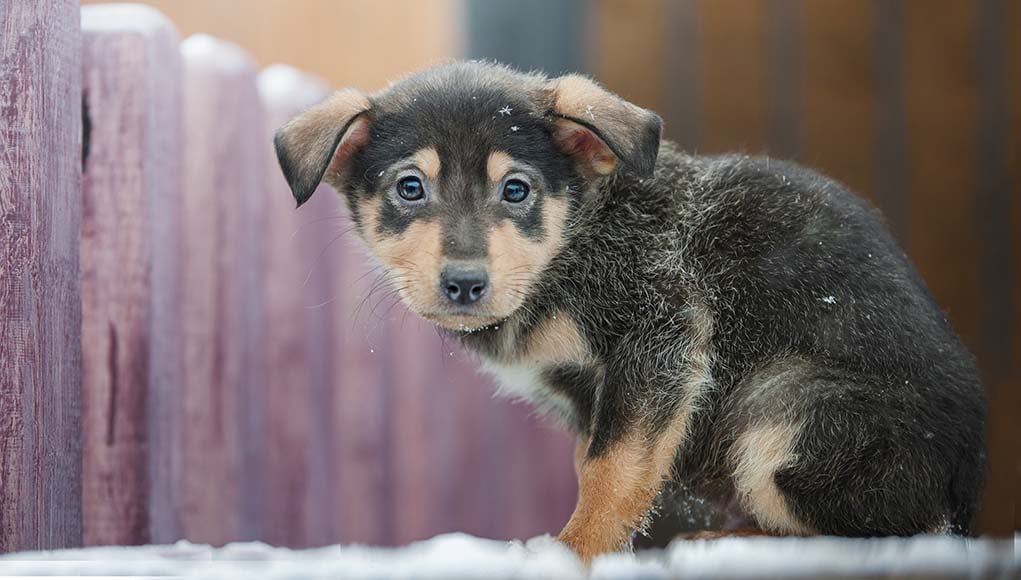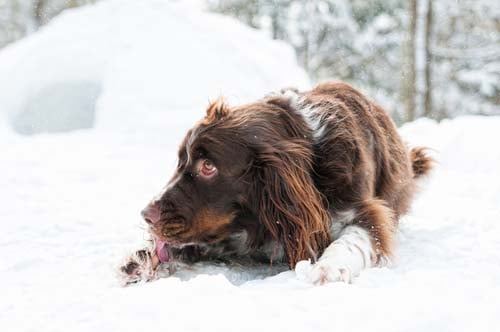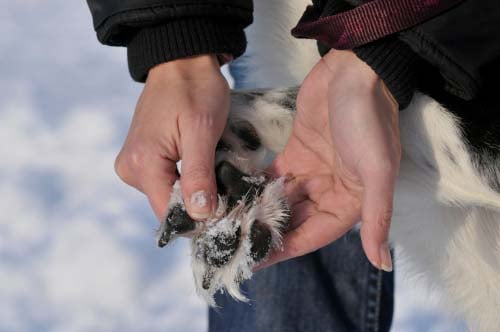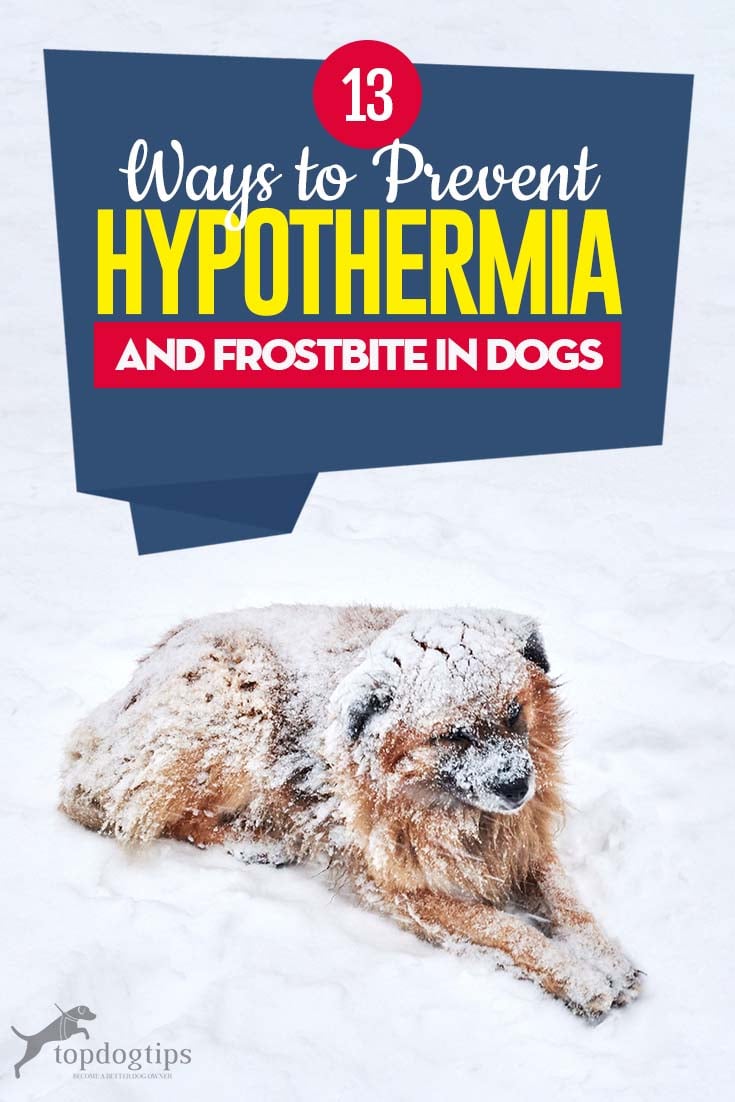The risk of hypothermia and frostbite in dogs is greatly increased when outdoor temperatures fall below 32 degrees Fahrenheit (0 degrees Celsius).
The normal range for a dog's body temperature is between 101 and 102.5° F (38.3 to 39.2° C). When your dog's body temperature drops below this range to a human range of 97.6 to 99.6° F (36.4 to 37.6° C), it's considered to be hypothermic.
Dogs that are exposed to unsafe cold temperatures outdoors for a long time are a high risk of hypothermia as well as getting frostbite on the tips of their ears, toes, and tail. Here's how to prevent this from happening.
1. Know Your Dog
Some breeds will handle cold better than others. A Siberian Husky will do fine where a Greyhound may be already cold. Similarly, certain individual dogs will be more or less at risk based on their current health and age.
For example, puppies or senior dogs are at a higher risk for hypothermia and frostbite due to weaker immune systems. Small dog breeds like Chihuahuas, those with short hair, or those without a double coat are also at higher risk.
Dogs with medical issues (e.g. diabetes, poor circulation, heart disease and kidney disease) will also be less resilient to the effects of cold weather because their body may not be strong enough to keep itself warm.
2. Know the Signs of Frostbite and Hypothermia
Symptoms of frostbite in dogs include pale skin with a bluish-white hue, and ice forming around the affected area, which will feel cold or brittle. When the body warms and blood returns to the affected area, the dog's skin will be swollen and red, and the skin will start to peel, like in the case of this Border Collie. This can lead to blisters or skin ulcers. If the dog's frostbite is severe, the area will turn black.
Signs of hypothermia in dogs include excessive shivering and trembling, followed by numbness. The dog can experience sleepiness, weakness, and lethargy. They'll have a decreased heart rate, low body temperature, difficulty breathing, and dilated pupils. The dog may also be in a stupor and have difficulty walking.
3. Get a Winter Wellness Vet Check
Cold temperatures can exacerbate underlying health issues like arthritis which can lead to frostbite and hypothermia in dogs, and make previous health problems even worse.
When temperatures are dropping low, have your vet perform a thorough examination to diagnose, treat, and help prevent cold-weather-triggered health issues before you go out for longer winter walks outside with your pup.
4. Winter Dog Safety: Ponds, Lakes and Rivers
Hiking with dogs in winter is fun, but there's a number of risks.
Regions with ponds, lakes and rivers can quickly become a safety hazard for your pooch. Don't let your pet run across bodies of water that may have thin ice. Even if they look solid, ice layers can vary. If your dog falls through, hypothermia will set in quickly and rescuing them may be next to impossible, even when risking your own safety.
Also, when you trail off too far from home or car during your hike, you may not have enough time to return, just as your dog starts losing body heat, especially in case of sudden temperature drop.
https://www.facebook.com/Detroitpitcrew/posts/1502723223191317
5. Avoid Soaking Wet Fur
If the snowfall is wet, or there is a strong wind, do not allow your dog to stay outside for long periods of time. When your Fido's coat becomes saturated, it is more difficult for them to produce body heat, and then hypothermia is right around the corner.
When the dog's fur gets soaked wet, towel-dry them, then wrap in a fresh warm towel or a warm blanket. You can also use a hot water bottle (wrapped in a protective cover to prevent burns) or pet heating pads against your dog's abdomen.
Offer your dog warm fluids such as low sodium chicken or beef broth.
6. Winter Weather Exercise
On very cold and wet winter days, shorten your daily doggy walks. Then, once you get back indoors, continue the exercise with a game of fetch or tug. It's just safer this way.
Do some training exercises, other games like using the stairs and play chasing, or a game of “keep away.” Allow your dog to use the treadmill, bring a dog-friend over for a play-date, or make your own indoor obstacle course using home furnishings. There are plenty of ways to entertain and exercise dogs indoors during winter months.
7. Wear Protective Gear
For longer walks in cold temperature, always dress up your dog appropriately. There's different winter clothing available for dogs of all sizes.
Essentials include protective pet winter jackets or sweaters that are both insulated and waterproof to prevent hypothermia. Winter dog booties not only protect the paws from frostbite but will also provide traction on ice and snow, and keep deicers and other dangerous chemicals from collecting on pads and in between the toes.
8. Check Your Pet's Paws
After your walk, check the dog's paws for any sign of damage such as bleeding, cracks in the pads or in the webbing between the toes. Frostbites on dog paws are common, and they could forever cripple your dog.
A sudden lameness during a winter walk may be due to ice accumulation between your dog's toes. Reduce the risk of this by clipping away the excess hair on the dog's paws and toes, or by using protective winter dog shoes instead.
9. Provide Choices
Scatter pet beds or appropriate-sized dog blankets in various locations around your home. These could be placed in front of a sunny window, in front of a heat source, or tucked away in a warm corner. By giving your dog choices, you are allowing them to warm up as needed, in comfort and peace.
10. Avoid Cold Cars
Since cars cool down very quickly when the heater's off, never leave your dog unattended in a vehicle. If you have to take the dog with you, then keep the vehicle's motor running with the heat on, or make sure your dog is wearing protective clothing.
11. Provide Outdoor Shelter
In some states, it's illegal to keep dogs outside. However, if you must keep your pet outside for extended periods of time (some dogs prefer to stay outdoors for long), build or purchase a proper shelter, such as a dog house.
The floor of the shelter should be well off the ground to minimize heat loss. Ideally, it's also insulated, like these winter dog houses. Provide thick bedding such as hay or special blankets, and change them as needed.
The door of the shelter should be on the wall that is away from prevailing winds. The enclosure should also be insulated and waterproof. Avoid using heat lamps or space heaters as these can burn your dog and be a fire hazard. Instead, there are some safe choice dog house heaters that are specially designed for that.
12. Healthy Diet
Underweight dogs will have a harder time maintaining their body temperature and will be at higher risk of hypothermia. Feed your dog a high quality, protein-based diet so they can maintain healthy body weight.
Calories may need to be increased slightly during winter times because dogs expend more of them. Very active dogs and those that live outdoors will need even more calories to maintain their ideal body weight and temperature in the winter months.
13. Be Prepared
Include your pet in your emergency weather kit, or have a separate one just for the dog.
Have enough food, water, and any medications for at least five days. Heavy snowfall and ice buildup can lead to your pet getting lost, so be sure their ID tag is up-to-date and their collar is secured in case they wander off. Having your dog microchipped prevents the loss of tags, but the information should also be kept current. When going hiking or long walks in snow and forest, use a GPS tracker for extra safety.
Hypothermia and frostbite in dogs can be prevented as long as you're aware and prepared. Know your dog's limits and follow these steps for a safe (and fun) winter.
READ NEXT: How to Keep Dogs Warm in Winter
















